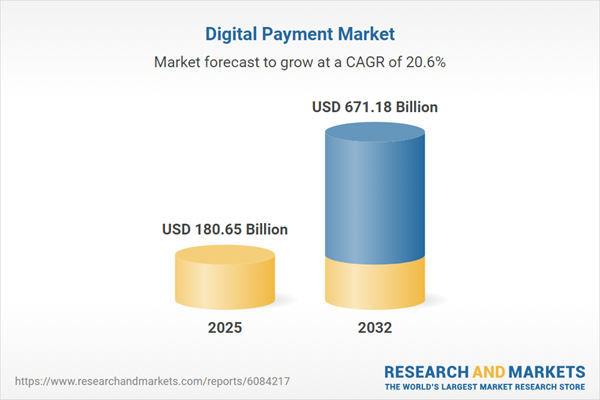Speak directly to the analyst to clarify any post sales queries you may have.
The digital payments market is experiencing a rapid evolution, driven by technological advancements and shifting consumer habits. As payment channels diversify and regulatory landscapes adapt, senior decision-makers require a comprehensive view of emerging risks and opportunities. This report delivers a structured analysis of digital payment trends, adoption drivers, segmentation, and competitive dynamics to inform strategic decision-making.
Market Snapshot: Digital Payment Market Growth and Outlook
The Digital Payment Market grew from USD 149.98 billion in 2024 to USD 180.65 billion in 2025 and is projected to maintain a compound annual growth rate (CAGR) of 20.60%, reaching USD 671.18 billion by 2032. This dynamic environment is underpinned by widespread adoption of mobile technologies, expansion of digital wallet offerings, and increasing support from global financial institutions. Businesses are facing new imperatives to modernize their payment infrastructures and align with heightened consumer expectations for efficiency, security, and integrated experiences.
Scope & Segmentation of the Digital Payments Market
This market research provides a thorough segmentation and regional analysis, capturing the full spectrum of digital payment activity across geographies and industries.
- Payment Method: Bank transfers (including ACH, SEPA, wire transfer), credit cards (co-branded, private label), debit cards, digital wallet options (closed and open wallet formats).
- Deployment Mode: API interfaces (RESTful, SOAP), hosted solutions (iframe, redirect), on-premise options (private cloud, self-hosted environments).
- Industry Vertical: BFSI sectors (banking, capital markets, insurance), healthcare (clinics, hospitals, pharmacies), retail (apparel, electronics, grocery), travel (airlines, hotels).
- Channel: Offline settings (restaurant and retail POS terminals, vending machines), omnichannel strategies, and online transactions.
- End User: Household and individual consumers, large enterprises, public sector entitles, and SMEs (micro, small, medium tiers).
- Transaction Type: E-commerce (desktop and mobile commerce), P2P payments (crypto, mobile P2P), POS activity.
- Device Type: Desktop, mobile (feature phone, smartphone), tablet, wearables (fitness trackers, smartwatches).
- Regional Coverage: Americas (including North America and Latin America), Europe, Middle East and Africa (with further detail on Europe, Middle East, Africa), Asia-Pacific.
- Company Coverage: Leading entities such as China UnionPay, Visa, Mastercard, American Express, PayPal, Ant Group, Fidelity National Information Services, Fiserv, Block, and Stripe.
Key Takeaways for Digital Payment Decision-Makers
- Technological advancement continues to reshape transaction models and customer engagement, enabling seamless omnichannel experiences across established and emerging markets.
- Collaborations between financial institutions and technology firms are accelerating the delivery of integrated, cloud-based payment solutions backed by advanced security protocols, AI, and machine learning.
- Regulatory frameworks are progressing, with open banking and central bank digital currency pilots encouraging innovation while demanding robust compliance.
- Peer-to-peer transfers, embedded payments, and digital wallet uptakes are influencing consumer behavior and redefining revenue opportunities for service providers.
- Cross-border payment solutions are transforming through distributed ledger technologies and alternative settlement systems, increasing efficiency and transparency for international transactions.
- Strategic alliances, targeted acquisitions, and investments in fraud prevention and ID verification are becoming essential for maintaining competitiveness and trust.
Analyzing Tariff Impact on Digital Payment Ecosystem
New tariff regulations introduced by the United States in 2025 have prompted recalibration in cross-border payment flows, operational costs, and compliance strategies. Higher import duties on technology infrastructure are elevating provider expenses, leading to the pursuit of alternative settlement options such as regional network solutions and, where regulated, cryptocurrency corridors. Data center localization and heightened scrutiny regarding tariff classifications further compel organizations to prioritize cost optimization, transparency, and resilient compliance frameworks.
Methodology & Data Sources
This analysis employs a hybrid research methodology, combining thorough secondary research from industry reports, regulatory documents, and technology studies, alongside proprietary data and expert interviews. Surveys from diverse stakeholders—including merchants, banking executives, and regulators—ensure accurate triangulation of digital payment adoption, technology trends, and user satisfaction.
Why This Report Matters for Senior Leaders
- Enables informed strategic planning with comprehensive segmentation, competitive profiling, and future-focused growth projections.
- Highlights key drivers of technological adoption and regulatory adaptation, supporting risk mitigation and market entry strategies.
- Offers actionable insights on partnership models, compliance imperatives, and regional dynamics crucial for organizational resilience.
Conclusion
Organizations poised for growth in the digital payments sector are those integrating agile platforms, leveraging advanced analytics, and proactively aligning with regional and global regulatory trends. The insights and recommendations herein equip decision-makers to navigate complexity, optimize operations, and capture evolving market opportunities.
Table of Contents
3. Executive Summary
4. Market Overview
7. Cumulative Impact of Artificial Intelligence 2025
Companies Mentioned
The companies profiled in this Digital Payment market report include:- China UnionPay Co., Ltd.
- Visa Inc.
- Mastercard Incorporated
- American Express Company
- PayPal Holdings, Inc.
- Ant Group Co., Ltd.
- Fidelity National Information Services, Inc.
- Fiserv, Inc.
- Block, Inc.
- Stripe, Inc.
Table Information
| Report Attribute | Details |
|---|---|
| No. of Pages | 191 |
| Published | November 2025 |
| Forecast Period | 2025 - 2032 |
| Estimated Market Value ( USD | $ 180.65 Billion |
| Forecasted Market Value ( USD | $ 671.18 Billion |
| Compound Annual Growth Rate | 20.6% |
| Regions Covered | Global |
| No. of Companies Mentioned | 11 |









